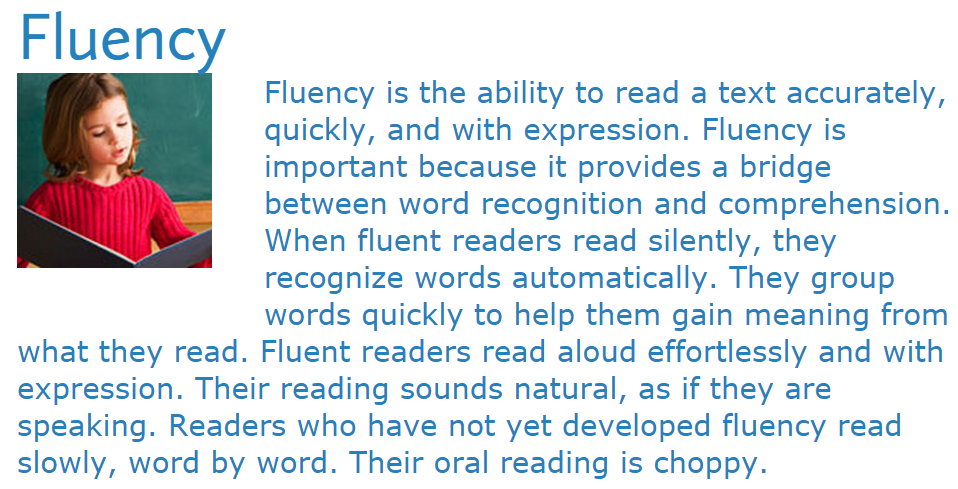Reading Accurately and Reading Fast
In any human cognitive task, a higher level of thinking is more likely to happen when basic skills have been mastered. The human brain with its limited working memory can focus more, for instance, on algebraic problems if the brain no longer needs to concentrate on correctly performing arithmetic operations. The same goes with reading. As a child becomes familiar with words, a child can now focus more attention on what meaning a series of words in a sentence are trying to express. In all disciplines of human learning, there is fluency.
Fluency in a language is obviously not a mere memorization or fast recall of words, but it requires nonetheless memories of meanings of words. When a child reads, it is important that words are correctly recognized. There is the ability called "orthography coding", which emphasizes words as unique arrays of letters. In this area, correct spelling is a key measure. Receptive vocabulary is another component of reading. This usually refers to words that one recognizes and understands upon hearing or reading. Both word recognition and receptive vocabulary are expected to play vital roles in reading comprehension. How each of these two factors influence comprehension is not clear when only accuracy in reading comprehension is measured.
When a task is completed not just correctly but also quickly, there is clearly additional evidence of fluency. Speed is not meant to replace comprehension, but with the increasing amount of text that need to be read in school, and even in real life, the rate at which one comprehends written material becomes important as well.
Measuring the time in a reading comprehension assessment is therefore useful especially if such gauge also untangles the two important factors behind reading comprehension: word recognition and vocabulary. This has been recently demonstrated in a study published in the Journal of Research in Reading. This research work by Louise Flensted Rønberg and Dorthe Klint Petersen from Denmark involves more than 200 fourth grade children and aims to understand how orthographic coding and receptive vocabulary correlate with reading comprehension.
Orthographic coding (word recognition) and receptive vocabulary have been separately measured via the following:
Assessments or exams now have negative connotations. Add speed or time pressure, impressions even become worse. There remains, however, some good in tests under time pressure. It remains one of the ways fluency can be measured.
 |
| Above copied from Reading Rockets |
When a task is completed not just correctly but also quickly, there is clearly additional evidence of fluency. Speed is not meant to replace comprehension, but with the increasing amount of text that need to be read in school, and even in real life, the rate at which one comprehends written material becomes important as well.
Measuring the time in a reading comprehension assessment is therefore useful especially if such gauge also untangles the two important factors behind reading comprehension: word recognition and vocabulary. This has been recently demonstrated in a study published in the Journal of Research in Reading. This research work by Louise Flensted Rønberg and Dorthe Klint Petersen from Denmark involves more than 200 fourth grade children and aims to understand how orthographic coding and receptive vocabulary correlate with reading comprehension.
Orthographic coding (word recognition) and receptive vocabulary have been separately measured via the following:
Orthographic coding (2 minutes, 70 items). The timed test measured the ability to recognise correctly spelled words, which may be seen as a measure of the children’s sight word representations in long-term memory (Nielsen & Petersen, 1992). The children were asked to circle the correctly spelled word amongst four homophone alternatives, for example reine – rain – rane – raine. The test was framed by the orthographic coding test developed by Olson, Kliegl, Davidson, and Foltz (1985). The score was the number of correct responses in 2 minutes.
Receptive oral vocabulary (30 items). The test consisted of a broad selection of 30 highfrequency and low-frequency everyday words and content area words (see appendix). Danish receptive vocabulary tests suited for group administration are few. Therefore, this new measure was developed by the first author. A selection of children’s fiction and non-fiction books were studied, and 56 words were selected. Appropriate photos of the target word and four distractors were found on web pages. The five photos per item were presented in colour in a paper booklet with three items per page. It was piloted with 100 children in Years 3–5. Based on Rasch analyses, the individual items were inspected, and the final test was constructed with 30 test items. All the words were orally presented twice by the test administrator. The score was the number of correct responses.Their findings show that if the reading comprehension exam is not timed, a child's vocabulary is a much more important predictor than orthographic coding. On the other hand, there is a marked increase in the influence of word recognition when reading speed is measured. Furthermore, a third factor independent from either coding or vocabulary emerges in explaining reading comprehension speed, a child's ability to connect word meanings (semantic relationship).
Assessments or exams now have negative connotations. Add speed or time pressure, impressions even become worse. There remains, however, some good in tests under time pressure. It remains one of the ways fluency can be measured.
Comments
Post a Comment